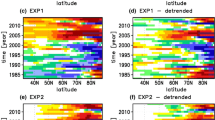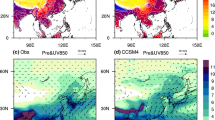Abstract
The ENSEMBLES multi-model and perturbed-parameter decadal re-forecasts are used to assess multi-year forecast quality for global-mean surface air temperature (SAT) and North Atlantic multi-decadal sea surface temperature variability (AMV). Two issues for near-term climate prediction, not discussed so far, are addressed with these two examples: the impact of the choice of the observational reference period, and of the number of years included in the forecast average. Taking into account only years when both observational and model data are available, instead of using the full record, to estimate observed climatologies produces systematically (although not statistically significantly different) higher ensemble-mean correlations and lower root mean square errors in all forecast systems. These differences are more apparent in the second half of the decadal prediction, which suggests an influence of non-stationary long-term trends. Also, as the forecast period averaged increases, the correlation for both global-mean SAT and AMV is generally higher. This also suggests an increasing role for the variable external forcing as when forecast period averaged increases, unpredictable internal variability is smoothed out. The results show that predicting El Niño-Southern Oscillation beyond one year is a hurdle for current global forecast systems, which explains the positive impact of the forecast period averaging. By comparing initialized and uninitialized re-forecasts, the skill assessment confirms that variations of the global-mean SAT are largely controlled by the prescribed variable external forcing. By contrast, the initialization improves the skill of the AMV during the first half of the forecast period. In an operational context, this would lead to improved predictions of the AMV from initializing internal climate fluctuations. The coherence between the multi-model and perturbed-parameter ensemble supports that conclusion for boreal summer and annual means, while the results show less consistency for boreal winter.









Similar content being viewed by others
Notes
The Third Coupled Model Intercomparison Project (CMIP3; Meehl et al. 2007).
References
Arribas A, Glover M, Maidens A, Peterson K, MacLachlan C, Graham R, Fereday D, Camp J, Scaife AA, Xavier P, McLean P, Colman A, Cusack S (2011) The GloSea4 ensemble prediction system for seasonal forecasting. Mon Weather Rev 139:1891–1910
Bladé I, Newman M, Alexander MA, Scott JD (2008) The late fall extratropical response to ENSO: sensitivity to coupling and convection in the tropical West Pacific. J Clim 21:6101–6118
Booth BBB, Dunstone NJ, Halloran PR, Andrews T, Bellouin N (2012) Aerosols implicated as a prime driver of twentieth-century North Atlantic climate variability. Nature 453:84–88
Branstator G, Teng H (2010) Two limits of initial-value decadal predictability in a CGCM. J Clim 23:6292–6311
Chang P, Zhang R, Hazeleger W, Wen C, Wan X, Ji L, Haarsma R, Breugem WP, Seidel H (2008) An oceanic bridge between abrupt changes in North Atlantic climate and the African monsoon. Nat Geosci 1:444–448
Dijkstra HA, te Raa LA, Schmeits M, Gerrits J (2006) On the physics of the Atlantic multidecadal oscillation. Ocean Dyn 56:36–50
Doblas-Reyes FJ, Weisheimer A, Déqué M, Keenlyside N, McVean M, Murphy JM, Rogel P, Smith D, Palmer TN (2009) Addressing model uncertainty in seasonal and annual dynamical seasonal forecasts. Q J R Meteorol Soc 135:1538–1559
Doblas-Reyes FJ, Weisheimer A, Palmer TN, Murphy JM, Smith D (2010) Forecast quality assessment of the ENSEMBLES seasonal-to-decadal Stream 2 hindcasts. ECMWF Tech Memo 621, Reading, 45 pp
Doblas-Reyes FJ, Balmaseda MA, Weisheimer A, Palmer TN (2011) Decadal climate prediction with the ECMWF coupled forecast system: impact of ocean observations. J Geophys Res 116:D19111. doi:10.1029/2010JD015394
García-Serrano J, Doblas-Reyes F J, Haarsma R J, Polo I (2012) Decadal prediction of the West African monsoon. J Geophys Res (under review)
Guan B, Nigam S (2009) Analysis of Atlantic SST variability factoring interbasin links and the secular trend: clarified structure of the Atlantic multidecadal oscillation. J Clim 22:4228–4240
Hawkins E, Sutton R (2009) The potential to narrow uncertainty in regional climate predictions. Bull Am Meterol Soc 90:1095–1107
Ineson S, Scaife AA (2009) The role of the stratosphere in the European climate response to ENSO. Nat Geosci 2:32–36
Joliffe IT, Stephenson DB (2003) Forecast verification. A practitioner’s guide in atmospheric science. Wiley, New York
Kalnay E et al (1996) The NCEP/NCAR 40-year reanalysis project. Bull Am Meterol Soc 77:437–470
Keenlyside N, Latif M, Jungclaus J, Kornblueh L, Roeckner E (2008) Advancing decadal-scale climate prediction in the North Atlantic sector. Nature 453:84–88
Knight JR, Folland CR, Scaife AA (2005) Climate impacts of the Atlantic multidecadal oscillation. Geophys Res Lett 33:L17706. doi:10.1029/2006GL026242
Meehl GA, Covey C, Delworth T, Latif M, McAvaney B, Mitchell JFB, Stouffer RJ, Taylor KE (2007) The WCRP CMIP3 multi-model dataset: a new era in climate change research. Bull Am Meterol Soc 88:1383–1394
Meehl GA, Goddard L, Murphy JM, Stouffer J, Boer G, Danabasoglu G, Dixon K, Giorgetta MA, Green AM, Hawkins E, Hegerl G, Karoly D, Keenlyside N, Kimoto M, Kirtman B, Navarra A, Pulwarty R, Smith DM, Stammer D, Stockdale T (2009) Decadal prediction: can it be skillful? Bull Am Meterol Soc 90:1467–1485
Mochizuki T, Ishii M, Kimoto M, Chikamoto Y, Watanabe M, Nozawa T, Sakamoto TT, Shiogama H, Awaji T, Suguira N, Toyoda T, Yasunaka S, Tatebe H, Mori M (2010) Pacific decadal oscillation hindcasts relevant to near-term climate prediction. Proc Natl Acad Sci 107:1833–1837
Mochizuki T, Chikamoto Y, Kimoto M, Ishii M, Tatebe H, Komuro Y, Sakamoto TT, Watanabe M, Mori M (2012) Decadal prediction using a recent series of MIROC global climate models. J Meteorol Soc Jpn 90A:373–383
Mohino E, Janicot S, Bader J (2010) Sahel rainfall and decadal to multi-decadal sea surface temperature variability. Clim Dyn. doi:10.1007/s00382-010-0867-2
Murphy JM, Kattsov V, Keenlyside N, Kimoto M, Meehl GA, Mehta V, Pohlmann H, Scaife AA, Smith D (2010) Towards prediction of decadal climate variability and change. Proced Environ Sci 1:287–304
Ottera OH, Bentsen M, Drange H, Suo L (2010) External forcing as a metronome for Atlantic multidecadal variability. Nat Geosci 3:688–694
Pielke RA (2008) Climate predictions and observations. Nat Geosci 1:206
Pohlmann H, Botzet M, Latif M, Roesch A, Wild M, Tschuck P (2004) Estimating the decadal predictability of a coupled AOGCM. J Clim 17:4463–4472
Pohlmann H, Jungclaus JH, Köhl A, Stammer D, Marotzke J (2009) Initializing decadal climate predictions with the GECCO oceanic synthesis: effects on the North Atlantic. J Clim 22:3926–3938
Pohlmann H, Smith DM, Balmaseda MA, da Costa ED, Keenlyside N, Masina S, Matei D, Muller WA, Rogel P (2011) Skillful predictions of the mid-latitude Atlantic meridional overturning circulation in a multi-model system. Geophys Res Lett (under review)
Smith DM, Cusack S, Colman AW, Folland CK, Harris GR, Murphy JM (2007) Improved surface temperature prediction for the coming decade from a global climate model. Science 317:796–799
Smith TM, Reynolds RW, Peterson TC, Lawrimore J (2008) Improvements to NOAA’s historical merged land-ocean surface temperature analysis (1880–2006). J Clim 21:2283–2296
Smith DM, Eade R, Dunstone NJ, Fereday D, Murphy JM, Pohlmann H, Scaife AA (2010) Skilful multi-year predictions of Atlantic hurricane frequency. Nat Geosci 3:846–849
Solomon A, Goddard L, Kumar A, Carton J, Deser C, Fukumori I, Green AM, Hegerl G, Kirtman B, Kushnir Y, Newmann M, Smith DM, Vimont D, Delworth T, Meehl GA, Stockdale T (2011) Distinguishing the roles of natural and anthropogenically forced decadal climate variability. Bull Am Meterol Soc 92:141–156
Sutton RT, Hodson DLR (2005) Atlantic Ocean forcing of North American and European summer climate. Science 309:115–118
Thompson DWJ, Lee S, Baldwin MP (2003) Atmospheric processes governing the northern hemisphere annular mode/North Atlantic Oscillation. In: Hurrell JW, Kushnir Y, Ottersen G, Visbeck M (eds) The North Atlantic Oscillation: climate significance and environmental impact. Geophys Monogr Ser 134:81–112
Trenberth KE, Shea DJ (2006) Atlantic hurricanes and natural variability in 2005. Geophys Res Lett 33:L12704. doi:10.1029/2006GL026894
van Oldenborgh GJ, te Raa LA, Dijkstra HA, Philip SY (2009) Frequency- or amplitude-dependent effects of the Atlantic meridional overturning on the tropical Pacific Ocean. Ocean Sci 5:293–301
van Oldenborgh GJ, Doblas-Reyes FJ, Wouters B, Hazeleger W (2012) Decadal prediction skill in a multi-model ensemble. Clim Dyn 38:1263–1280
von Storch H, Zwiers FW (2001) Statistical analysis in climate research. Cambridge University Press, Cambridge
Yasunaka S, Ishii M, Kimoto M, Mochizuki T, Shiogama H (2011) Influence of XBT temperature bias on decadal climate prediction with a coupled climate model. J Clim 24:5303–5308
Zieba A (2010) Effective number of observations and unbiased estimators of variance for autocorrelated data—an overview. Metrol Meas Syst 1:3–16
Acknowledgments
This work was supported by the EU-funded QWeCI (FP7-ENV-2009-1-243964) and the MICINN-funded RUCSS (CGL2010-20657) projects. The authors acknowledge the significant contributions by Geert Jan van Oldenborgh (KNMI, The Netherlands) and helpful comments from three anonymous reviewers. Technical support at Climate Forecasting Unit (IC3) is gratefully acknowledged.
Author information
Authors and Affiliations
Corresponding author
Rights and permissions
About this article
Cite this article
García-Serrano, J., Doblas-Reyes, F.J. On the assessment of near-surface global temperature and North Atlantic multi-decadal variability in the ENSEMBLES decadal hindcast. Clim Dyn 39, 2025–2040 (2012). https://doi.org/10.1007/s00382-012-1413-1
Received:
Accepted:
Published:
Issue Date:
DOI: https://doi.org/10.1007/s00382-012-1413-1




